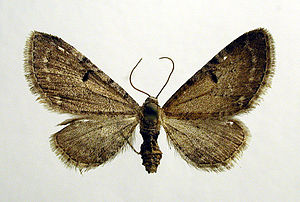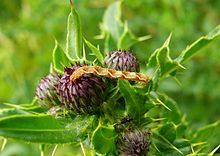Moth
| Moth | ||||||||||||
|---|---|---|---|---|---|---|---|---|---|---|---|---|

|
||||||||||||
| Systematics | ||||||||||||
|
||||||||||||
| Scientific name | ||||||||||||
| Eupithecia | ||||||||||||
| Curtis , 1825 |


The moths ( Eupithecia ) are a genus of butterflies from the family of the moths (Geometridae). The type species of the genus is Phalaena absinthiata Clerck , 1759.
features
The drawing of the forewings usually includes somewhat indistinct basal , antemedial and postmedial transverse lines. The post-medial line is often not sharply bent twice near the Costa loader. The discal spots are usually clearly developed. On the forewings, the R 1 vein is long and does not merge with the Sc vein. The areole can be provided with cross veins. The veins M 3 and CuA 1 arise separately from the cell on the hind wings . The hind tibia have two pairs of spurs.
In the males, the uncus is usually membranous. Basally it is broadest and at the top it is sclerotic , hook-like and pointed. One or two tips can be formed. In some species the uncus is completely membranous and spatulate. The blades are variable in size and shape and often have the shape of an orange segment. In some species ventral processes are formed. The juxta is broadest transversely, oval or kidney-shaped and has two narrow apical lobes at the tip . The vesica of the aedeagus is provided with one or more differently shaped cornuti. These can be horn-shaped, tubular, toothed, or flat and convoluted, and sometimes with a patch of small needles. The sternum A8 is usually widest at the base and has a shallow depression at the base. This has a constant shape within a species, but for some species it can also be slightly variable.
In females, the copulatrix bursa is membranous to severely sclerotic. The size and shape is variable and in some species a membranous diverticulum (a sac-shaped protuberance) may be present at the base. The bursa copulatrix can be provided with a number of signs, the position of which is variable. The colliculum is well developed and sclerotized. It is collar or plate-shaped. The antevaginal lamella is absent. The spurs of the anterior apophyses are either prominent and have an enlarged apex, or they are reduced.
The moths are characterized by very narrow wings. The wingspan of the mostly very small moths is usually between 12 and 28 millimeters. In the resting position, the wings are stretched, placed almost at right angles or slightly angled, with the hind wings being wholly or partially hidden behind the forewings.
The caterpillars are predominantly slender and, in most species, feed on the flowers and fruits of the food plants. That is why the German name Blütenspanner is used for the genus .
Systematics
The genus Eupithecia includes more than 1300 species worldwide, of which 139 are also represented in Europe. Eupithecia is thus the species-richest genus of the spanners and one of the most species-rich genera of butterflies. The following list is limited to the European species.
- Eupithecia abbreviata Stephens , 1831
- Eupithecia abietaria ( Goeze , 1781)
- Eupithecia absinthiata ( Clerck , 1759)
- Eupithecia actaeata Walderdorff , 1869
- Eupithecia addictata Dietze , 1908
- Eupithecia alliaria Staudinger , 1870
- Eupithecia analoga Djakonov , 1926
- Eupithecia antalica Mironov , 2001
- Eupithecia assimilata Doubleday , 1856
- Eupithecia Barteli Dietze , 1908
- Eupithecia biornata Christoph , 1867
- Eupithecia boryata ( Rebel , 1906)
- Eupithecia breviculata ( Donzel , 1837)
- Eupithecia carpophagata Staudinger , 1871
- Eupithecia cauchiata ( Duponchel , 1831)
- Eupithecia centaureata ( Denis & Schiffermüller , 1775)
- Eupithecia cerussaria ( Lederer , 1855)
- Eupithecia chalikophila Wehrli , 1926
- Eupithecia cocciferata Millière , 1864
- Eupithecia conterminata ( Lienig , 1846)
- Eupithecia cooptata Dietze , 1903
- Eupithecia cretaceata ( Packard , 1874)
- Eupithecia cuculliaria ( Rebel , 1901)
- Eupithecia denotata ( Huebner , 1813)
- Eupithecia denticulata ( Treitschke , 1828)
- Eupithecia dissertata ( Püngeler , 1905)
- Eupithecia distinctaria Herrich-Schäffer , 1848
- Eupithecia dodoneata Guenée , 1858
- Eupithecia druentiata Dietze , 1902
- Eupithecia dubiosa Dietze , 1910
- Eupithecia egenaria Herrich-Schäffer , 1848
- Eupithecia ericeata ( Rambur , 1833)
- Eupithecia exiguata ( Huebner , 1813)
- Eupithecia expallidata Doubleday , 1856
- Eupithecia extensaria ( Freyer , 1844)
- Eupithecia extraversaria Herrich-Schäffer , 1852
- Eupithecia extremata ( Fabricius , 1787)
- Eupithecia fennoscandica boys , 1949
- Eupithecia fuscicostata Christoph , 1887
- Eupithecia gelidata Moschler , 1860
- Eupithecia gemellata Herrich-Schäffer , 1861
- Eupithecia gomerensis ( Rebel , 1917)
- Eupithecia graphata ( Treitschke , 1828)
- Eupithecia gratiosata Herrich-Schäffer , 1861
- Eupithecia groenblomi Urbahn , 1969
- Eupithecia gueneata Millière , 1862
- Eupithecia haworthiata Doubleday , 1856
- Eupithecia icterata ( de Villers , 1789)
- Eupithecia immundata ( Lienig , 1846)
- Eupithecia impurata ( Huebner , 1813)
- Eupithecia indigata ( Huebner , 1813)
- Eupithecia innotata ( Hufnagel , 1767)
- Eupithecia insigniata ( Hübner , 1790)
- Eupithecia intricata ( Zetterstedt , 1839)
- Eupithecia inturbata ( Huebner , 1817)
- Eupithecia irriguata ( Huebner , 1813)
- Eupithecia karadaghensis Mironov , 1988
- Eupithecia lanceata ( Huebner , 1825)
- Eupithecia laquaearia Herrich-Schäffer , 1848
- Eupithecia lariciata ( Freyer , 1841)
- Eupithecia latipennata Prout , 1914
- Eupithecia lentiscata Mabille , 1869
- Eupithecia liguriata Millière , 1884
- Eupithecia limbata Staudinger , 1879
- Eupithecia linariata ( Denis & Schiffermüller , 1775)
- Eupithecia marginata Staudinger , 1892
- Eupithecia maspalomae Pinker , 1961
- Eupithecia massiliata Millière , 1865
- Eupithecia mekrana Brandt , 1941
- Eupithecia millefoliata Rossler , 1866
- Eupithecia minusculata Alpheraky , 1882
- Eupithecia moecha Dietze , 1902
- Eupithecia mystica Dietze , 1910
- Eupithecia nachadira Brandt , 1941
- Eupithecia nanata ( Huebner , 1813)
- Eupithecia ochridata Schütze & Pinker , 1968
- Eupithecia ogilviata ( Warren , 1905)
- Eupithecia orana Dietze , 1913
- Eupithecia orphnata W. Petersen , 1909
- Eupithecia oxycedrata ( Rambur , 1833)
- Eupithecia pantellata Millière , 1875
- Eupithecia pauxillaria Boisduval , 1840
- Eupithecia pernotata Guenée , 1858
- Eupithecia phoeniceata ( Rambur , 1834)
- Eupithecia pimpinellata ( Huebner , 1813)
- Eupithecia plumbeolata ( Haworth , 1809)
- Eupithecia poecilata Püngeler , 1888
- Eupithecia praealta Wehrli , 1926
- Eupithecia pulchellata Stephens , 1831
- Eupithecia pusillata ( Denis & Schiffermüller , 1775)
- Eupithecia pygmaeata ( Hübne r, 1799)
- Eupithecia pyreneata Mabille , 1871
- Eupithecia quercetica Prout , 1938
- Eupithecia reisserata Pinker , 1976
- Eupithecia repentina Vojnits & de Laever , 1978
- Eupithecia riparia Herrich-Schäffer , 1851
- Eupithecia rosai Pinker , 1962
- Eupithecia rosmarinata Dardoin & Millière , 1865
- Eupithecia santolinata Mabille , 1871
- Eupithecia sardoa Dietze , 1910
- Eupithecia satyrata ( Huebner , 1813)
- Eupithecia scalptata Christoph , 1885
- Eupithecia schiefereri Bohatsch , 1893
- Eupithecia schuetzeata Pinker , 1961
- Eupithecia scopariata ( Rambur , 1833)
- Eupithecia selinata Herrich-Schäffer , 1861
- Eupithecia semigraphata Bruand , 1850
- Eupithecia senorita Mironov , 2003
- Eupithecia silenata Assmann , 1848
- Eupithecia silenicolata Mabille , 1867
- Eupithecia simpliciata ( Haworth , 1809)
- Eupithecia sinuosaria ( Eversmann , 1848)
- Eupithecia spadiceata Zerny , 1933
- Eupithecia spissilineata ( Metzner , 1846)
- Eupithecia stertzi ( Rebel , 1911)
- Eupithecia subfuscata ( Haworth , 1809)
- Eupithecia suboxydata Staudinger , 1897
- Eupithecia subumbrata ( Denis & Schiffermüller , 1775)
- Eupithecia succenturiata ( Linnaeus , 1758)
- Eupithecia sutiliata Christoph , 1876
- Eupithecia tantillaria Boisduval , 1840
- Eupithecia tenerifensis ( Rebel , 1906)
- Eupithecia tenuiata ( Huebner , 1813)
- Eupithecia thalictrata ( Püngeler , 1902)
- Eupithecia thurnerata Sagittarius , 1958
- Eupithecia tripunctaria Herrich-Schäffer , 1852
- Eupithecia trisignaria Herrich-Schäffer , 1848
- Eupithecia ultimaria Boisduval , 1840
- Eupithecia undata ( Freyer , 1840)
- Eupithecia unedonata Mabille , 1868
- Eupithecia unitaria Herrich-Schäffer , 1852
- Eupithecia usbeca Viidalepp , 1992
- Eupithecia valerianata ( Huebner , 1813)
- Eupithecia variostrigata Alpheraky , 1876
- Eupithecia venosata ( Fabricius , 1787)
- Eupithecia veratraria Herrich-Schäffer , 1848
- Eupithecia virgaureata Doubleday , 1861
- Eupithecia vulgata ( Haworth , 1809)
- Eupithecia weissi Prout , 1938
supporting documents
- ↑ a b c Vladimir Mironov: The Geometrid Moths of the World . In: Axel Hausmann (Ed.): The Geometrid Moths of Europe . 1st edition. Volume 4: Larentiinae II. Perizomini and Eupitheciini . Apollo Books, Stenstrup 2003, ISBN 87-88757-40-4 , pp. 72 (English).
- ↑ Malcolm J. Scoble: Geometrid moths of the world. A catalog (Lepidoptera: Geometridae). Apollo Books, Stenstrup 1999, ISBN 0-643-06304-8
- ↑ a b Eupithecia at Fauna Europaea. Retrieved August 24, 2012
Web links
- Lepiforum e. V. Taxonomy and Photos